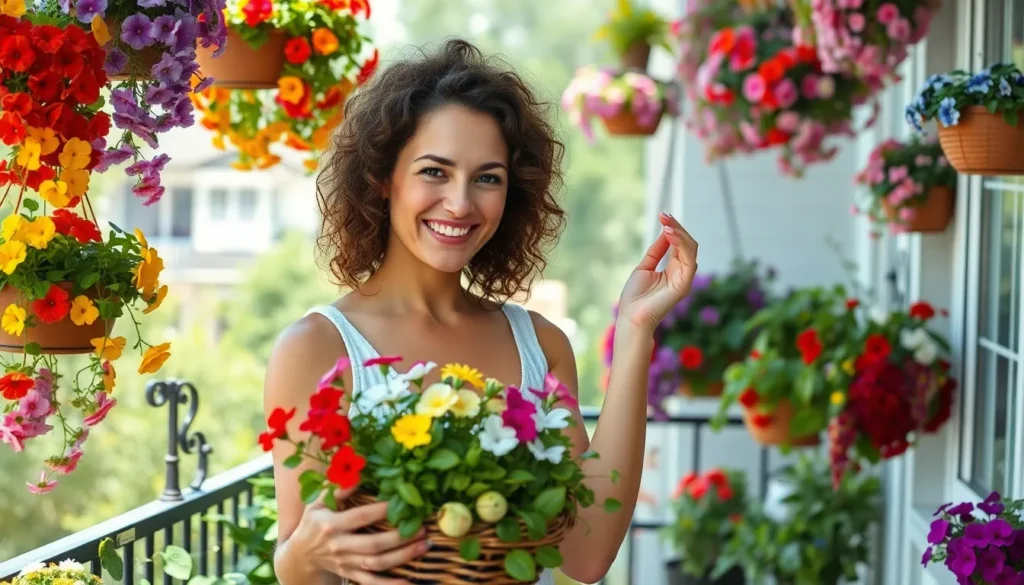Transforming your outdoor space doesn’t require a complete garden overhaul or expensive landscaping. Hanging baskets offer one of the most versatile and budget-friendly ways to add instant color dimension and charm to any porch patio or garden area.
We’ve discovered that the right hanging basket arrangements can completely change how your outdoor space feels and looks. Whether you’re working with a small balcony or sprawling backyard these elevated gardens create visual interest at eye level while maximizing your growing space. From cascading flowers that spill beautifully over basket edges to herb gardens that keep fresh ingredients within arm’s reach the possibilities are endless.
The best part? You don’t need to be a gardening expert to create stunning displays that’ll have your neighbors asking for tips. With the right plant combinations proper care techniques and creative container choices you can achieve professional-looking results that thrive throughout the growing season.
Colorful Flowering Hanging Baskets for Vibrant Outdoor Displays
We’ll explore the most stunning flowering plants that create eye-catching hanging basket displays throughout the growing season. These colorful options will transform your outdoor spaces into vibrant showcases.
Petunias and Impatiens for Continuous Blooms
Petunias deliver consistent flowering performance from spring through the first frost, making them ideal for hanging basket displays. Wave petunias cascade beautifully over basket edges, creating flowing waterfalls of color in shades like purple, pink, white, and red. Grandiflora varieties produce large 4-inch blooms that serve as stunning focal points, while multiflora types offer smaller but more abundant flowers.
Impatiens complement petunias perfectly with their shade tolerance and non-stop blooming habit. New Guinea impatiens thrive in both sun and partial shade, producing vibrant flowers in orange, salmon, pink, and white. Standard impatiens work exceptionally well in shadier locations where many other flowering plants struggle to perform.
We recommend combining trailing petunias with upright impatiens for balanced basket compositions. Plant 3-4 petunias around the basket’s edge with 2-3 impatiens in the center for optimal coverage. Both plants require regular watering and benefit from weekly liquid fertilizer applications to maintain their prolific blooming.
Fuchsias for Shaded Areas
Fuchsias excel in partially shaded locations where their delicate, pendant flowers create elegant hanging displays. These plants produce distinctive two-toned blooms with colorful sepals and contrasting petals in combinations like purple and pink, red and white, or deep burgundy and lavender. Trailing varieties such as ‘Gartenmeister Bonstedt’ and ‘Marinka’ cascade gracefully from hanging containers.
Temperature considerations play a crucial role in fuchsia success, as these plants prefer cool conditions between 60-70°F during the day. Morning sun with afternoon shade provides ideal growing conditions, protecting the flowers from intense heat that can cause wilting. We’ve found that east-facing locations offer the perfect balance of light and protection.
Care requirements include consistent moisture without waterlogged conditions and regular pinching of spent blooms to encourage continued flowering. Feed fuchsias every two weeks with balanced liquid fertilizer diluted to half strength. Bring containers indoors before the first frost, as most fuchsia varieties won’t survive freezing temperatures.
Begonias for Long-Lasting Color
Begonias provide reliable color from late spring through fall, offering both flowering and foliage interest in hanging basket arrangements. Tuberous begonias produce large, rose-like blooms in vibrant shades of red, orange, yellow, pink, and white that can reach 6 inches across. Trailing varieties like ‘Illumination’ series create stunning cascading displays perfect for elevated containers.
Wax begonias deliver smaller but more many flowers along with attractive glossy foliage that ranges from green to bronze-red. These compact plants work well as thriller plants in mixed arrangements or as standalone displays in smaller baskets. Dragon Wing begonias offer the best of both worlds with continuous blooms and attractive wing-shaped leaves.
We position begonia hanging baskets in locations with morning sun and afternoon shade for optimal performance. These plants prefer consistently moist but well-draining soil conditions. Remove spent flowers regularly to promote continued blooming, and apply diluted liquid fertilizer every 2-3 weeks throughout the growing season. Begonias can be overwintered indoors as houseplants in bright, cool locations.
Cascading Plant Arrangements That Create Stunning Visual Impact
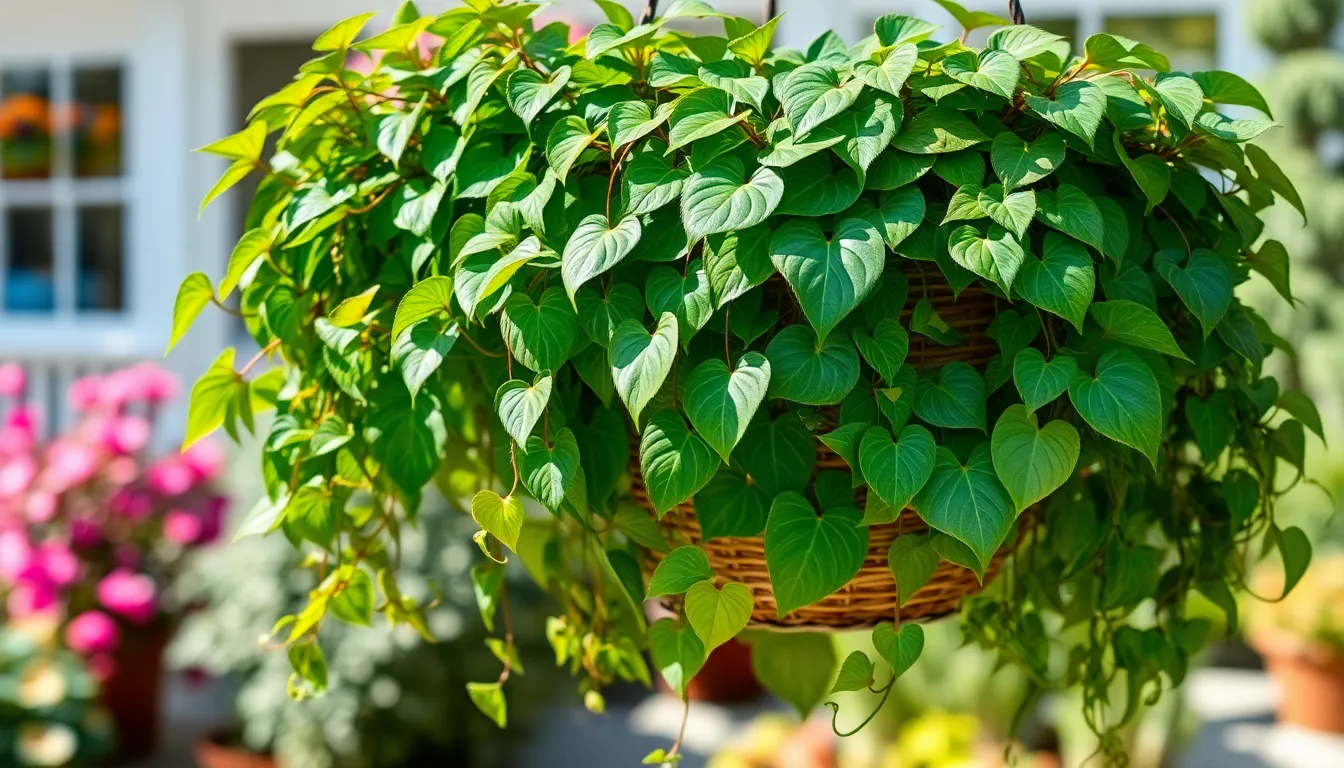
Moving beyond single flower varieties, we can create dramatic visual effects by combining plants that naturally trail and cascade over basket edges. These arrangements use the proven “thrill, fill, and spill” formula where spillers create that gorgeous flowing effect that transforms ordinary hanging baskets into stunning focal points.
Trailing Ivy and Pothos Combinations
Ivy delivers classic elegance with its rich green foliage that cascades beautifully down basket sides, creating a timeless garden look. This reliable trailing plant thrives in partial shade conditions and prefers well-drained soil for optimal growth.
Pothos adds variegated interest when combined with ivy, especially in warmer climates where its trailing vines can flourish outdoors. The contrasting leaf patterns between solid green ivy and variegated pothos create stunning texture combinations.
Combining these two trailing powerhouses produces lush, green cascades that bring natural garden charm to any outdoor space. Both plants share similar care requirements, making them perfect partners for low-maintenance displays that still deliver maximum visual impact.
Cascading Petunias and Bacopa Mixes
Petunias provide vibrant color cascades with their long-lasting blooms that elegantly spill over basket edges throughout the growing season. These popular flowering plants, along with similar million bells (Calibrachoa), create ever-changing displays in sunny locations.
Bacopa offers delicate complement with its small flowers and trailing growth habit that fills spaces between petunias with softer texture. This gentle trailing plant creates beautiful contrast against petunias’ bold blooms.
Together, these flowering partners deliver both colorful blooms and lush trailing greenery that thrives in full sun to partial shade conditions. The combination provides continuous visual interest from spring through fall when properly maintained.
Flowing Sweet Potato Vine Displays
Sweet potato vine creates vigorous cascades with its extensive trailing habit and colorful foliage ranging from lime green to deep purple. This dramatic vine produces flowing displays that pair perfectly with upright flowering plants.
Vigorous growth makes this vine ideal for filling large baskets quickly, creating substantial cascading effects that can reach several feet in length. The colorful foliage adds year-long interest even when other plants aren’t blooming.
Full sun conditions bring out the best colors in sweet potato vines, which thrive in bright locations with moist, well-drained soil. This makes them perfect spillers for sunny outdoor hanging baskets that need bold, flowing elements.
Herb Garden Hanging Baskets for Functional Outdoor Spaces
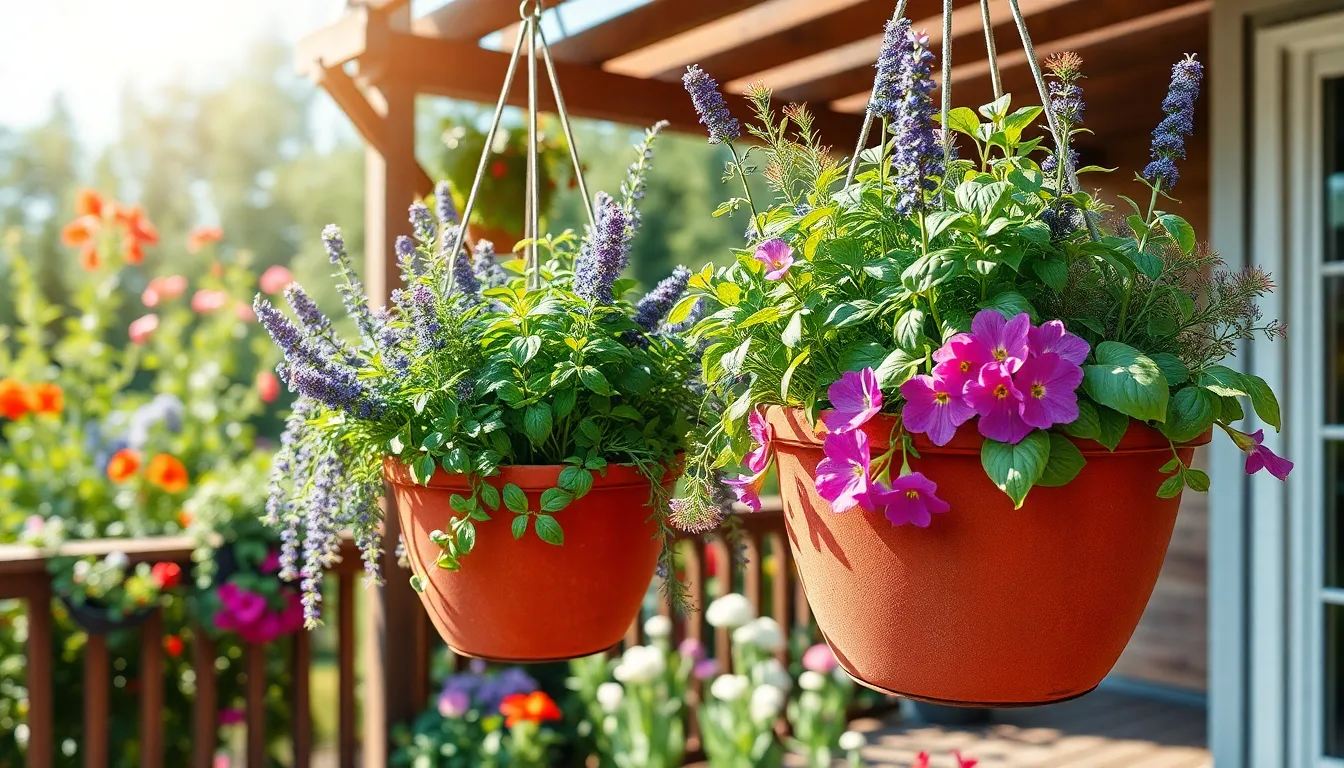
We can transform our outdoor spaces into productive gardens by creating hanging baskets filled with herbs that combine beauty with practicality. These elevated herb gardens maximize limited outdoor space while providing easy access to fresh culinary and medicinal plants at eye level.
Culinary Herb Combinations
Mediterranean trinity baskets work exceptionally well for everyday cooking needs. Basil, parsley, and oregano thrive together in sunny conditions and complement each other’s growth patterns. These three herbs share similar watering requirements and provide essential ingredients for Italian and Mediterranean dishes.
Partial shade combinations offer versatility for areas with limited direct sunlight. Thyme, chives, and mint create an excellent grouping for partial sun locations, though we recommend containing mint within the basket to prevent it from overtaking other plants. Creeping thyme adds trailing beauty while maintaining its culinary value.
Drought tolerant pairings suit sunny locations with less frequent watering schedules. Rosemary and sage form perfect partnerships as both woody herbs tolerate dry conditions and require well-drained soil. Their upright growth habits work well in the center of baskets, while trailing herbs like lemon balm cascade over the edges.
Aromatic Herb Arrangements
Fragrant focal points create sensory experiences that enhance outdoor living spaces. Lavender, rosemary, and lemon balm produce a delightful combination of scents that intensify when brushed against or warmed by sunlight. Different leaf textures between these herbs add visual interest while their fragrances complement rather than compete.
Sweet companion plantings incorporate flowering plants that support the herb garden’s appeal. Sweet alyssum provides delicate, honey-scented flowers that pair beautifully with aromatic herbs without overwhelming their natural fragrances. This combination creates hanging baskets that engage multiple senses throughout the growing season.
Medicinal Plant Selections
Immune supporting herbs offer natural health benefits alongside ornamental value. Echinacea provides both purple cone flowers and immune system support when properly harvested and prepared. These upright plants work well in basket centers, requiring full sun and good drainage.
Healing and calming varieties create therapeutic hanging gardens for wellness focused spaces. Calendula produces bright orange flowers with skin healing properties, while chamomile offers delicate, daisy-like blooms perfect for calming teas. Both plants need adequate sunlight (6+ hours daily) and good airflow to prevent mildew issues.
Growing requirement matching ensures successful medicinal herb baskets. We group plants with similar needs for sunlight, water, and soil drainage to prevent compatibility issues. High-quality compost provides the nutrient foundation these therapeutic plants need, while proper spacing allows for healthy growth and easy harvesting.
Succulent Hanging Baskets Perfect for Low-Maintenance Gardens
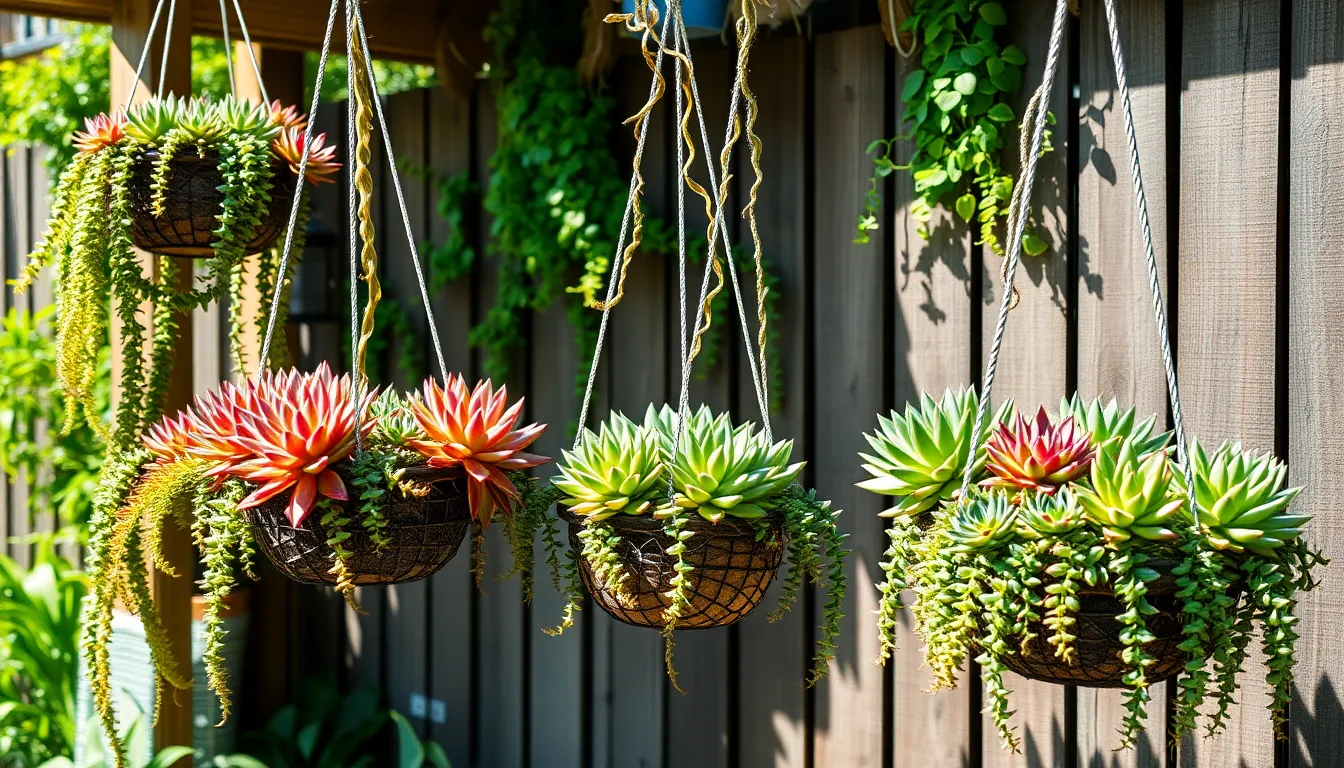
Succulents offer the ultimate solution for busy gardeners who want stunning hanging displays without constant maintenance. These drought-tolerant plants create beautiful cascading arrangements that thrive in outdoor conditions while requiring minimal water and care.
Drought-Tolerant Succulent Varieties
Rainbow Bush (Portulacaria afra variegata) stands out as one of our favorite choices for outdoor hanging baskets. This cascading beauty features variegated green and cream leaves that create elegant trailing displays. Blooming occurs from late spring to early summer with lovely lavender-pink flowers, and it thrives in USDA zones 10-11.
Calico Kitten (Crassula marginalis rubra ‘Variegata’) brings romantic charm to any hanging arrangement. Soft pink, cream, and green heart-shaped leaves trail gracefully over basket edges. Flowering happens in late spring with delicate pale pink or white blooms, and this variety flourishes in USDA zones 9-11 with bright, indirect light.
Donkey Tail (Sedum morganianum) proves incredibly popular for its spiky, trailing nature and exceptional heat tolerance. Handling drought conditions and root-bound environments with ease, this tough succulent thrives in hot sun exposure. Growing densely packed, blue-green leaves create stunning waterfall effects in hanging displays.
Graptopetalum and Sedum species provide excellent options for full-sun locations. Graptopetalum paraguayense and various sedums demonstrate remarkable hardiness in drought-resistant outdoor hanging gardens. Tolerating dry soil and root-bounded conditions, these varieties require minimal maintenance while delivering maximum visual impact.
Mixed Succulent Arrangements
Combining multiple succulent varieties creates texturally diverse and visually striking hanging baskets. Positioning trailing species at basket edges allows them to cascade downward while upright succulents fill the center spaces. This layering technique creates depth and dimensional interest in your displays.
Variegated and colorful-leaved succulents add vibrant pops of color to mixed arrangements. Pairing soft pastel Calico Kitten with spiky green sedums creates beautiful contrast in both texture and hue. These combinations work especially well when you match plants with similar water and light requirements.
Trailing varieties like Rainbow Bush or Donkey Tail should drape elegantly over basket edges for the best cascading effect. Mixing these with more compact, upright growing succulents ensures your arrangement has both spillover appeal and central fullness.
Hanging Succulent Garden Designs
Lightweight containers with excellent drainage prevent root rot and make hanging easier on support structures. Choose baskets with multiple drainage holes and consider adding a layer of gravel at the bottom for extra water management.
Bright outdoor areas with protection from harsh midday sun provide ideal growing conditions for most succulent varieties. Morning sun and afternoon shade locations work particularly well for maintaining healthy growth without sun stress.
Seasonal color combinations can incorporate flowering plants alongside succulents for burst of seasonal interest. Adding small flowering annuals around the edges while keeping succulents as the main feature creates ever-changing displays that change throughout the growing season.
Similar light and water requirements should guide your plant selection process when creating mixed arrangements. Grouping drought-tolerant succulents together ensures all plants thrive under the same care routine, making maintenance simple and effective.
Seasonal Hanging Basket Ideas That Change Throughout the Year
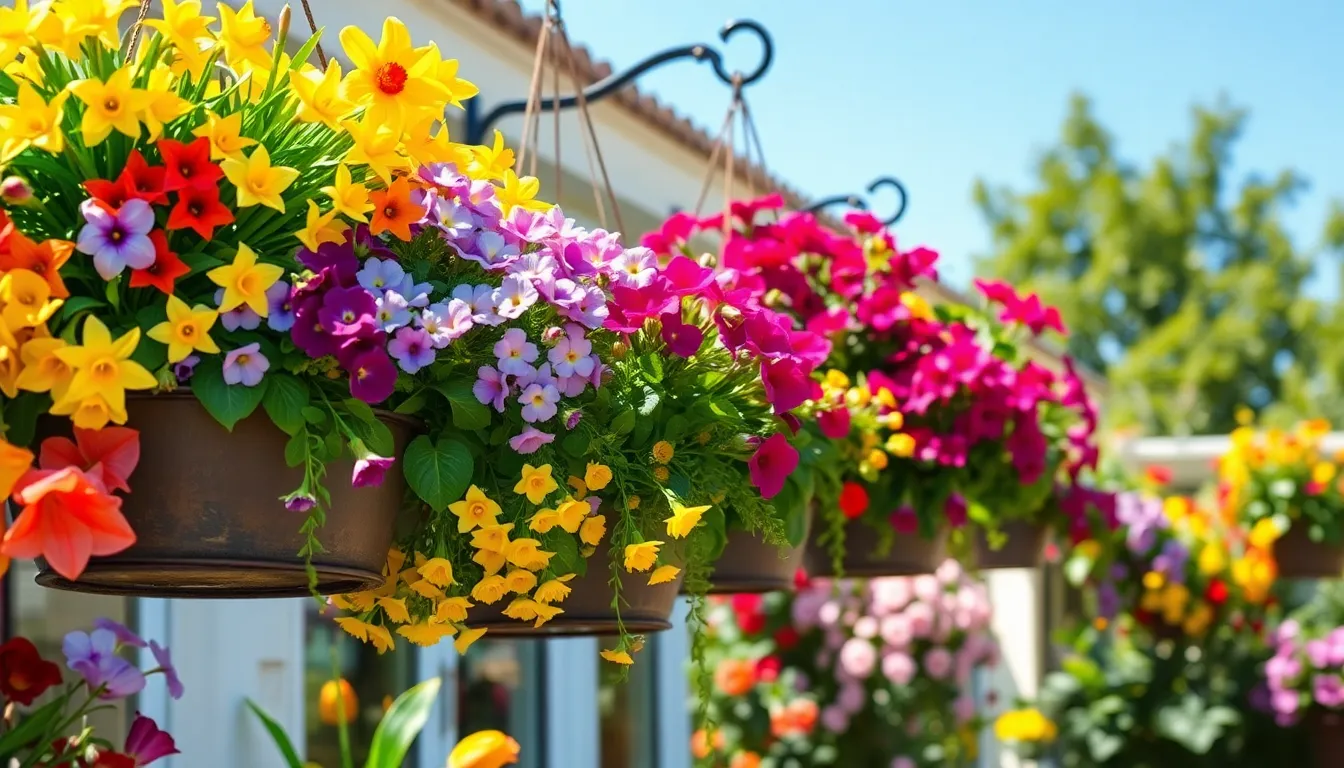
Creating year round outdoor displays becomes effortless when we match our hanging basket plants to each season’s unique conditions. Seasonal plant selections ensure our displays remain vibrant and healthy throughout changing weather patterns.
Spring Bulb and Early Flower Combinations
Spring bulbs offer the perfect foundation for our earliest hanging basket displays of the year. Daffodils, tulips, and crocus provide essential structure and height while delivering those first welcome bursts of seasonal color. Combining these bulbs with trailing companions like pansies or violas creates multi textured arrangements that capture spring’s fresh energy.
Early flowering plants thrive in cooler temperatures and shorter daylight hours typical of spring months. Pansies handle light frosts beautifully while their cheerful faces complement the upright growth of spring bulbs. Violas add delicate trailing elements that soften basket edges without overwhelming the stronger bulb displays.
Lighter, brighter flower combinations work best during spring when we want our baskets to echo the season’s renewed vitality. These fresh color palettes create perfect transitions from winter’s dormant period into summer’s abundant growing season.
Summer Heat-Resistant Plant Selections
Heat tolerant plants become essential for maintaining lush summer hanging baskets that withstand intense sun and high temperatures. Our top selections include proven varieties that deliver continuous blooms while handling occasional watering challenges.
Petunias dominate summer hanging basket choices with their large, colorful blooms and pleasant fragrance. Dramatic varieties like Petunia ‘Back to Black’ feature velvety black flowers that create stunning focal points. ‘Amore™ Queen of Hearts’ produces striking red hearts on yellow backgrounds for bold color combinations.
Dragonwing Begonias excel in heat with their glossy leaves and continuous flowers from spring through frost. These versatile plants thrive in full sun to part shade conditions while tolerating occasional watering delays. Morning watering prevents leaf scorch during peak heat hours.
Geraniums remain summer staples that prefer morning sun with afternoon shade protection. Regular feeding and deadheading ensure abundant blooms throughout the hottest months. Their sturdy stems and classic flower clusters provide reliable structure for mixed arrangements.
Fuchsias offer spectacular trailing blooms that thrive in semi shade locations. Their large, dramatic flowers create elegant displays while their cascading habit softens harsh container edges. Indoor overwintering extends their lifespan for multiple seasons.
Fall and Winter Evergreen Arrangements
Evergreen plants and interesting foliage selections maintain basket appeal during colder months when flowering options become limited. These hardy choices provide year round structure while adding seasonal interest through berries and colorful leaves.
Small conifers or boxwood create essential framework elements that survive freezing temperatures. Holly and winterberry contribute colorful berry displays that attract winter wildlife while adding natural seasonal decoration. Ornamental kale offers vibrant foliage colors that intensify as temperatures drop.
Trailing ivy provides movement and textural contrast against upright evergreen companions. Heuchera adds foliage interest with its colorful leaves that often persist through mild winters. These combinations create focal points that remain attractive even during dormant seasons.
Winter arrangements require plants that maintain their structure and visual appeal even though harsh weather conditions. Strategic plant placement and proper container selection ensure our displays continue improving outdoor spaces throughout the year’s most challenging months.
Creative Container Options Beyond Traditional Hanging Baskets
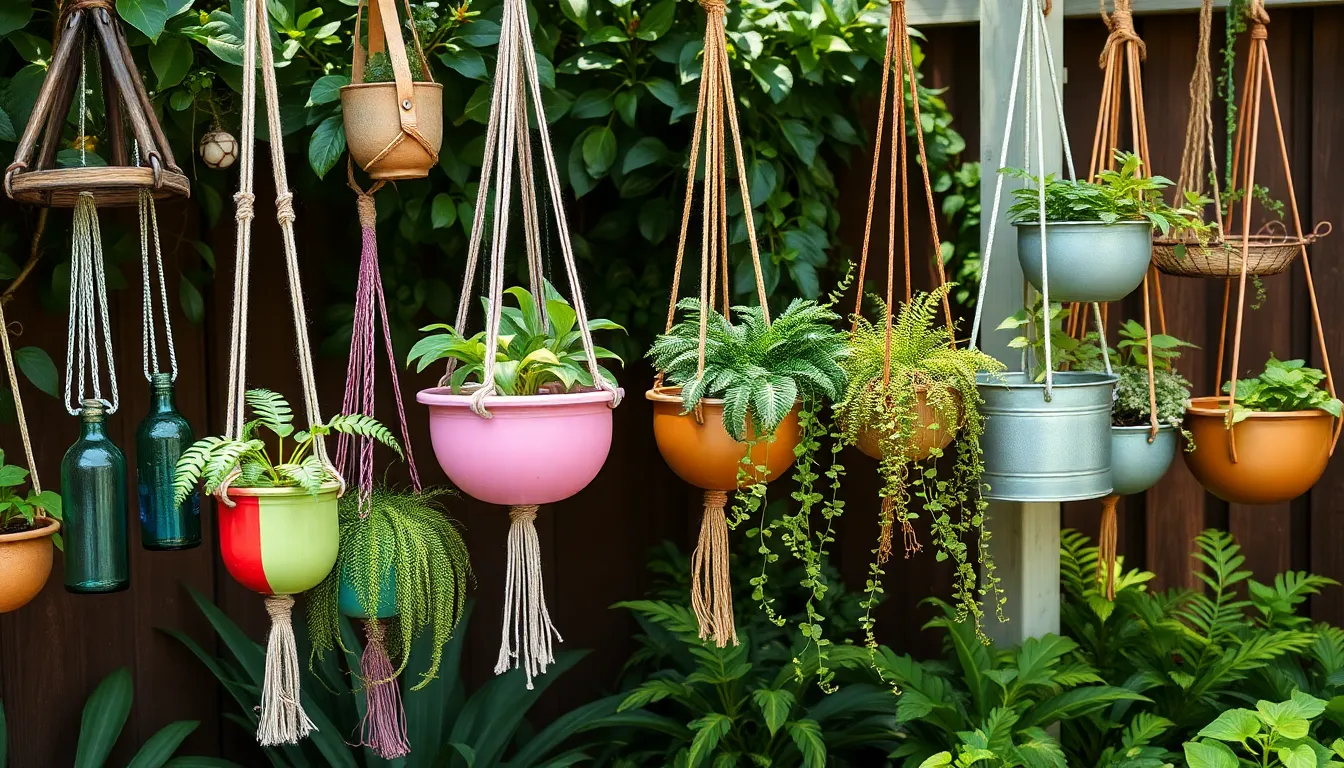
Breaking away from conventional hanging baskets opens up a industry of creative possibilities for our outdoor spaces. We can transform everyday items into stunning planters while adding unique character to our gardens.
Repurposed Household Items as Planters
Household items offer endless possibilities for creating one-of-a-kind hanging planters that won’t break the budget. Glass bottles wrapped with twine create rustic displays when suspended from tree branches or pergolas. Kitchen castoffs like colanders, teapots, and old buckets bring whimsical charm to our outdoor spaces while serving as functional planters.
Old shoes, tins, and woven baskets transform into conversation pieces with simple drainage holes added to the bottom. We can personalize these containers with paint, decorative elements, or weathered finishes to match our garden’s aesthetic. Repurposing items reduces waste while creating eco-friendly planters that tell a story and spark conversations with visitors.
Macrame and Fabric Hanging Planters
Macrame plant hangers bring bohemian elegance to our outdoor displays through intricate knotted cord designs. These lightweight alternatives work perfectly for ferns, trailing vines, or small flowering plants that need gentle support. We can adjust the height and style of macrame hangers to fit any space while adding textural interest to our garden arrangements.
Fabric planters crafted from weather-resistant textiles offer flexibility in both design and placement. These soft containers can be folded into various shapes and hung almost anywhere due to their minimal weight. Durable outdoor fabrics withstand the elements while providing a softer alternative to rigid containers, creating comfortable-looking displays that complement natural garden settings.
Wooden and Metal Alternative Containers
Wooden containers bring natural warmth to our hanging displays while supporting heavier plants and soil loads. Crates, boxes, and slatted containers can be suspended with chains or sturdy ropes, developing beautiful weathered patinas over time. We can customize wooden planters with stains, paints, or decorative hardware to match our outdoor décor preferences.
Metal containers deliver industrial style or vintage charm depending on our chosen materials and finishes. Galvanized buckets, repurposed lanterns, and custom-made metal baskets create striking focal points in our garden designs. These sturdy alternatives accommodate larger plant arrangements and can be painted or treated to prevent rust while maintaining their distinctive character for years of outdoor use.
Strategic Placement Tips for Maximum Outdoor Hanging Basket Impact

We’ve covered the plants and containers, but now it’s time to focus on where and how you position your hanging baskets to create the most stunning outdoor displays.
Optimal Height and Spacing Guidelines
Hang baskets at eye level or slightly above to maximize visibility and create the most dramatic visual impact. This positioning allows you to fully appreciate the cascading arrangements we discussed earlier while making maintenance tasks like watering and deadheading much easier.
Space your baskets far enough apart to allow proper airflow between plants. Overcrowding prevents good air circulation, which can lead to fungal diseases and stunted growth in your petunias, begonias, and herbs. We recommend leaving at least 3-4 feet between larger baskets and 2-3 feet between smaller ones.
Consider creating groupings at varying heights to add visual depth to your outdoor space. Stagger your succulent arrangements, herb baskets, and flowering displays at different levels to create a layered effect that draws the eye upward and makes your space feel more ever-changing.
Sun and Shade Considerations
Identify your outdoor area’s sun exposure patterns throughout the day before placing any baskets. Sun loving plants like Easy Wave Petunias, rosemary, and lavender need at least 6 hours of direct sunlight daily to produce their best blooms and maintain healthy growth.
Position shade tolerant varieties like impatiens, fuchsias, and begonias in areas that receive morning sun but afternoon protection. These plants thrive in filtered light conditions, making them perfect for covered patios, under eaves, or areas shaded by larger trees.
Group plants with similar light requirements together to ensure uniform growth and simplified care routines. This strategy prevents you from having to move baskets frequently and ensures all plants in a grouping receive appropriate light levels for optimal health.
Wind Protection Strategies
Position baskets near walls, fences, or under protective overhangs to shield them from damaging wind gusts. Strong winds can quickly dry out soil, damage delicate flowers, and cause your carefully arranged cascading plants to become tangled or broken.
Use heavier containers or upgrade your hanging hardware when placing baskets in exposed locations. Wrought iron planters provide more stability than lightweight options, while secure mounting systems prevent dangerous swinging or falling during storms.
Select wind resistant plant varieties if your outdoor space faces consistent breezes. Succulents like Donkey Tail and Rainbow Bush naturally handle windy conditions better than delicate flowering plants, making them ideal choices for exposed balconies or open garden areas.
Maintenance and Care Essentials for Thriving Outdoor Hanging Gardens
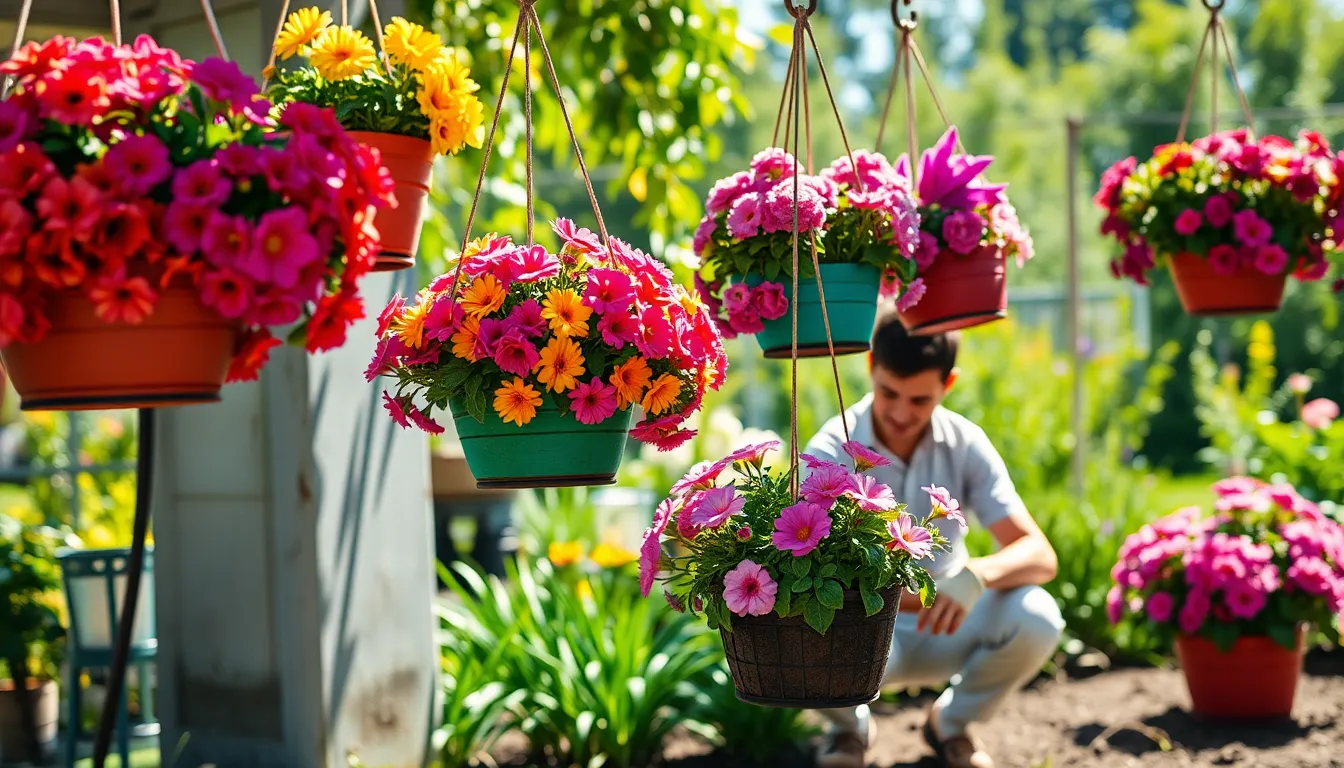
Successful outdoor hanging baskets require consistent care and attention to flourish throughout the growing season. We’ll guide you through the essential maintenance practices that keep your elevated gardens healthy and vibrant.
Watering Schedules and Techniques
Daily moisture checks are crucial since hanging baskets dry out faster than ground plants due to wind and sun exposure. Insert your finger about an inch deep into the soil to test moisture levels and water deeply whenever it feels dry.
Morning watering provides the best results by supplying plants with moisture throughout the day’s heat while preventing overnight root diseases. Large baskets measuring 14 inches or more typically require about 2 gallons of water per watering session, though amounts vary based on weather conditions and plant size.
Proper drainage prevents root rot by maintaining evenly moist but not soggy soil conditions. Avoid overwatering as waterlogged roots quickly lead to plant stress and disease problems.
Fertilizing Requirements
Balanced water soluble fertilizer applied every 1 to 2 weeks replenishes nutrients that container plants consume rapidly. Regular feeding ensures continuous growth and flowering throughout the season.
Slow release fertilizers like G&B Organics Bud & Bloom or Osmocote Plant Food provide ongoing nutrition with less frequent applications. These products deliver steady nutrient release over several months.
Liquid bloom boosters such as Scott’s Super Bloom supplement regular feeding to promote vibrant flowering displays. Apply these specialized fertilizers during peak growing periods for maximum color impact.
Pruning and Deadheading Practices
Weekly deadheading of spent blooms encourages continuous flowering while maintaining attractive basket appearance. Remove faded flowers by pinching or cutting stems just above the next set of leaves.
Self cleaning varieties including Calibrachoa and Million Bells eliminate deadheading requirements since they naturally drop spent blooms. These low maintenance options save time while providing consistent color.
Periodic pruning maintains plant shape and encourages bushier growth patterns that prevent legginess. Trim back overgrown stems to promote fuller, more compact plant forms that enhance your hanging basket’s overall appearance.
Conclusion
Your outdoor hanging basket journey starts with a single container and endless possibilities. Whether you’re drawn to vibrant flowering displays cascading herbs or low-maintenance succulents there’s a perfect combination waiting for your space.
We’ve shown you that successful hanging gardens don’t require extensive gardening experience or expensive materials. With proper plant selection strategic placement and consistent care you’ll create stunning vertical displays that transform any outdoor area into a living masterpiece.
Remember to consider your exact growing conditions and choose plants that thrive in your environment. Mix textures colors and growth habits to achieve those eye-catching arrangements that make your neighbors stop and admire.
Start small experiment with different combinations and let your creativity flourish. Your outdoor space deserves the beauty and charm that only well-designed hanging baskets can provide.
Frequently Asked Questions
What are the main benefits of using hanging baskets in outdoor spaces?
Hanging baskets offer a cost-effective way to transform any outdoor area without extensive landscaping. They maximize growing space by utilizing vertical areas, add instant color and visual interest, and work well in spaces of any size. These elevated gardens are perfect for small balconies, patios, or large backyards, making them accessible to gardeners of all skill levels.
Which flowering plants work best in hanging baskets?
Petunias and impatiens are excellent choices for continuous blooms, with petunias creating beautiful cascading effects and impatiens thriving in shaded areas. Fuchsias add elegance to shaded spots but require cool temperatures and consistent moisture. Begonias offer long-lasting color and versatility, thriving in morning sun with afternoon shade protection.
What is the “thrill, fill, and spill” formula for hanging baskets?
The “thrill, fill, and spill” formula creates visually striking arrangements by combining three plant types: a tall centerpiece plant (thrill), medium-height plants to fill space (fill), and trailing plants that cascade over the edges (spill). This technique ensures balanced, professional-looking displays with varied heights and textures.
Can I grow herbs in hanging baskets?
Yes, herbs make excellent hanging basket plants, combining beauty with practicality. For sunny spots, try basil, parsley, and oregano. For partial shade, consider thyme, chives, and mint. Drought-tolerant options like rosemary and sage work well in sunny locations with less frequent watering. Use high-quality compost and proper spacing for best results.
Are succulents good for hanging baskets?
Succulents are perfect for low-maintenance hanging baskets. Varieties like Rainbow Bush, Calico Kitten, and Donkey Tail create stunning cascading effects while requiring minimal care. Use lightweight containers with excellent drainage, and combine multiple succulent varieties for visually striking displays that tolerate drought conditions.
How do I create year-round hanging basket displays?
Match plants to seasonal conditions for continuous interest. Spring: use bulbs like daffodils and tulips with trailing pansies. Summer: choose heat-resistant plants like petunias and geraniums. Fall/Winter: incorporate evergreens like small conifers, boxwood, and ornamental kale to maintain visual appeal during colder months.
Where should I position hanging baskets for best results?
Hang baskets at eye level or slightly above for visibility and easy maintenance. Ensure proper spacing for airflow and consider sun/shade patterns when positioning plants. Group baskets with similar light requirements together. Protect from strong winds by placing near walls or using heavier containers, and choose wind-resistant plant varieties for exposed areas.
How often should I water and maintain hanging baskets?
Check moisture levels daily, as hanging baskets dry out faster than ground plants. Water thoroughly when the top inch of soil feels dry. Use balanced fertilizers regularly for healthy growth. Practice deadheading and pruning to maintain appearance and encourage continuous blooming. Consistent care is key to thriving hanging garden displays.

